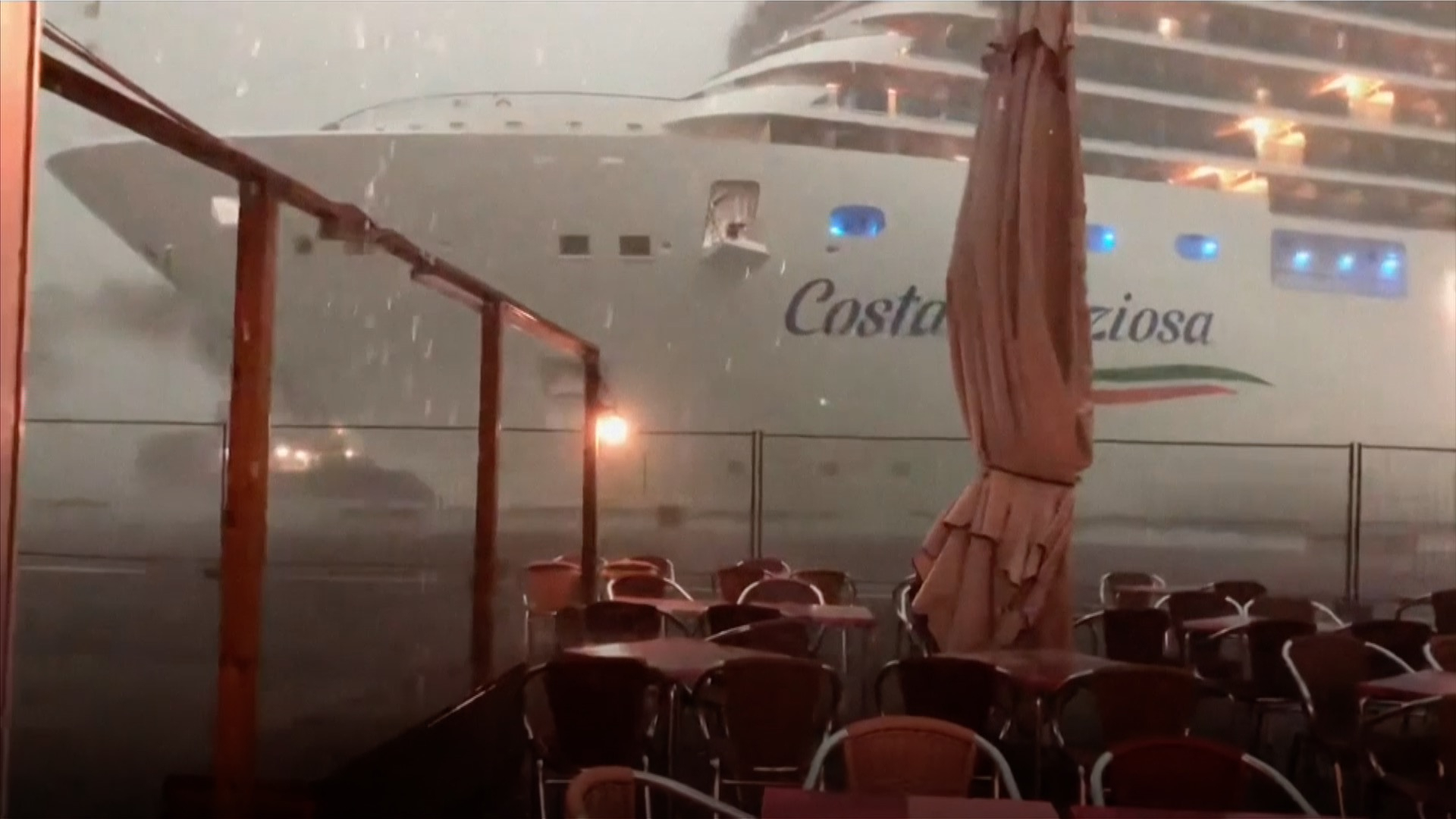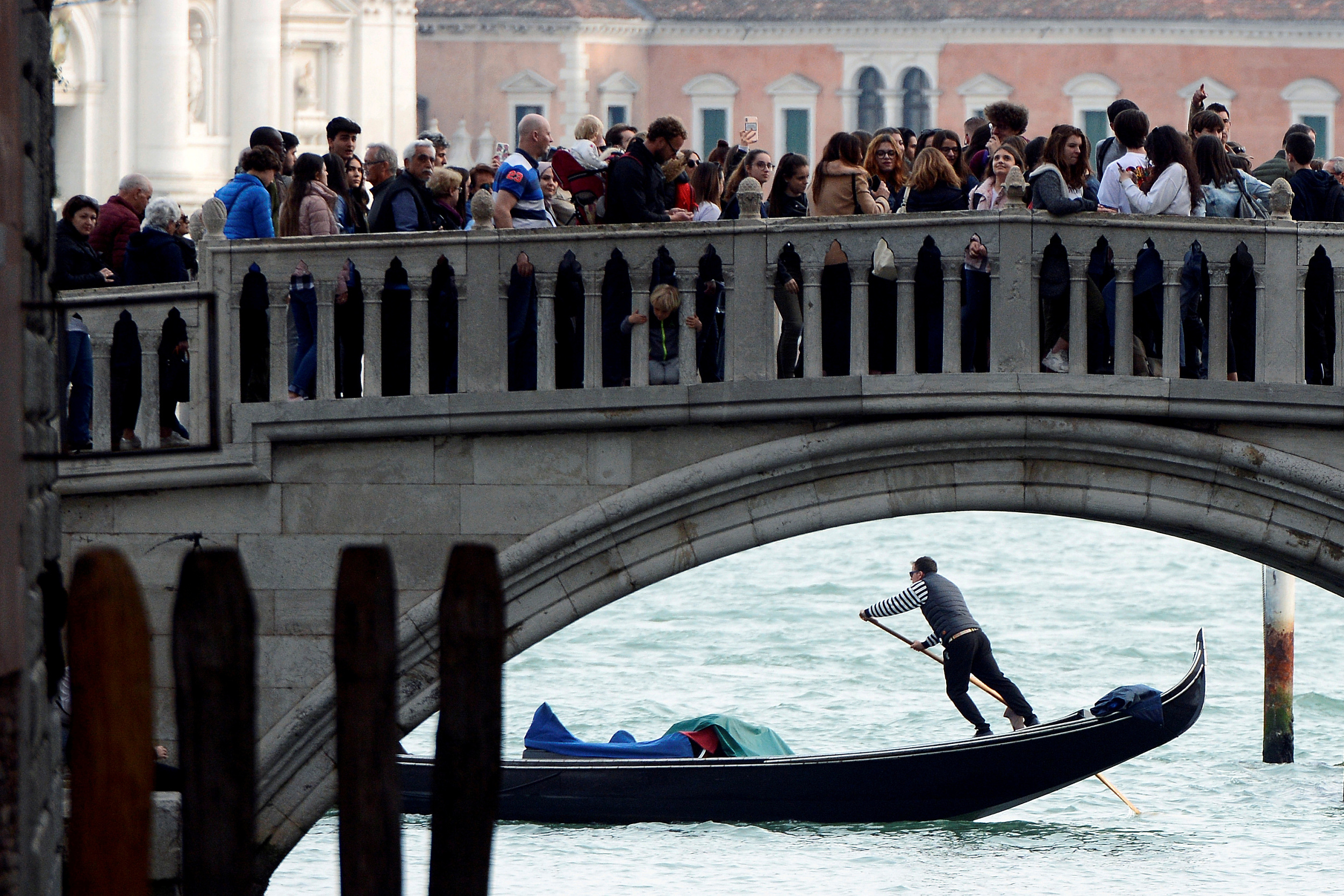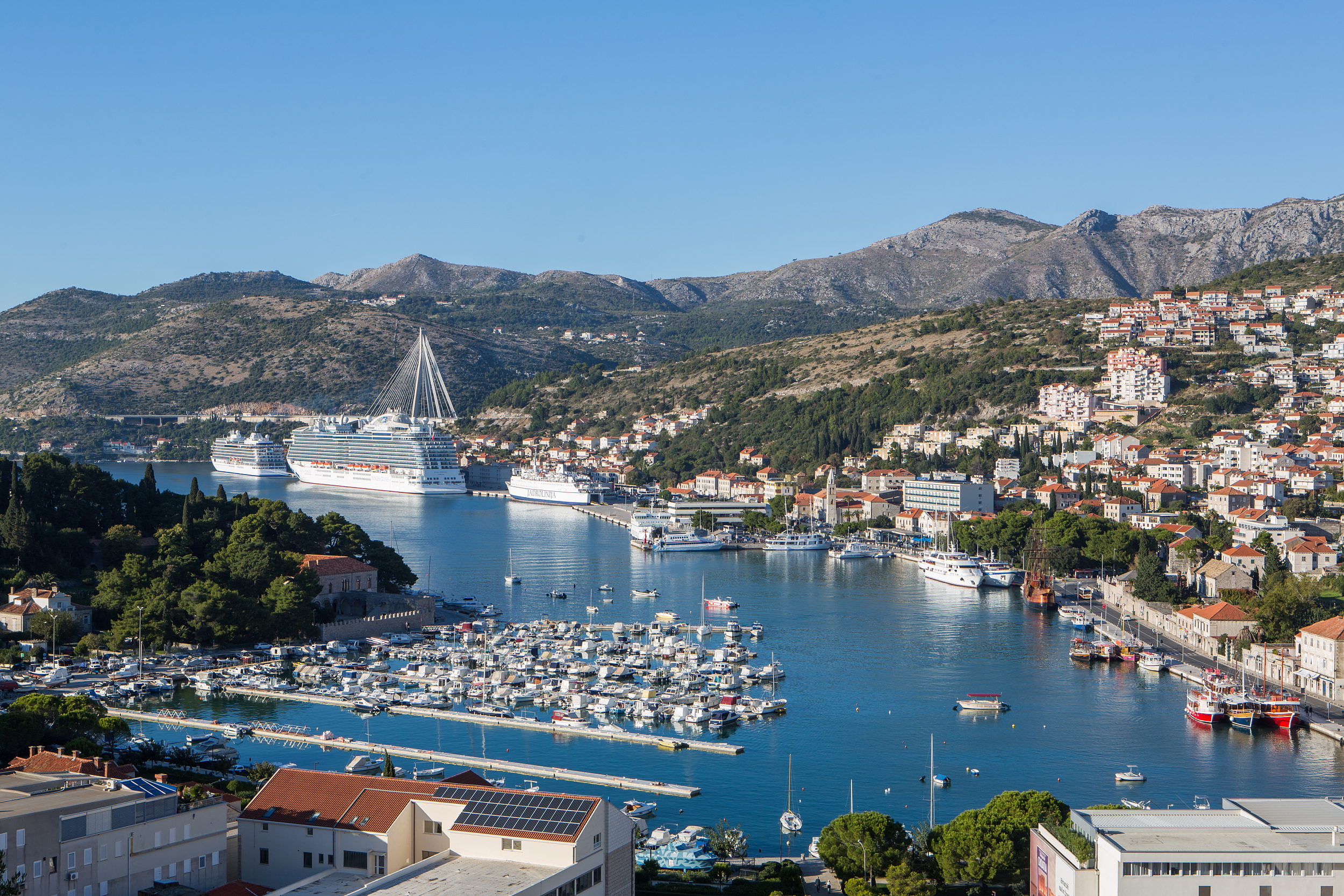

A protester holds a flag reading "No Grandi Navi" (No big ships) during a demonstration against cruise ships sailing into the Venice lagoon, close to Piazza San Marco in Venice, Italy, June 8, 2019. /VCG Photo
Rain lashed down, a siren sounded, and waves splashed onto the quay as a massive white liner scraped by: a near-collision with a cruise ship in Venice over the weekend once again illustrated the battle that cities in Europe are waging against mass tourism.
Nobody was hurt and there appeared to have been no damage, but video of the floating palace bearing down on a waterfront restaurant before veering off and barely missing a docked yacht reignited the controversy over cruise ships in the Venetian lagoon.
In June, a 13-deck cruise ship, the MSC Opera, rammed into a dock and a tourist riverboat in the historic Italian city, sending people fleeing and leaving four tourists lightly injured. The ship had apparently experienced an engine failure.
In the latest incident, the Costa Deliziosa reportedly lost control in a rain storm.
Cruise control
Venice is not the only city to have struggled with a global hike in cruise ship tourism.
Last week, the mayor of Barcelona, Ada Colau, vowed to drastically reduce the number of cruise ships docking in the Spanish city. In 2018, over 2.5 million passengers visited Barcelona, making it the top cruise ship destination in Europe.

Dubrovnik, Croatia's "Jewel of the Adriatic" and a UNESCO World Heritage site like Venice, announced in October that it would start limiting the number of liners that could stop in its port to two per day – or about 5,000 passengers – to combat overcrowding in its historic streets.
The Belgian city of Bruges has said it plans to introduce a similar curb, while in the Spanish resort of Palma de Mallorca, locals have been campaigning for a cap.
Cruise ship tourism has experienced a major spike over the past few years. From 2011 to 2016, the number of cruise ship passengers worldwide shot up 21 percent to 24.7 million people. In 2018, there were 28.5 million, according to Cruise Lines International Association.
Opponents complain that cruise ships discharge huge numbers of day visitors who swarm a city for a few hours, clogging up narrow streets and inconveniencing locals, while hardly contributing to the local economy as they do not book hotel rooms or eat in local restaurants.
A matter of survival
In Venice, cruise ships are not just a nuisance but an existential threat. The massive liners that plow through the Giudecca canal between Piazza San Marco and San Giorgio Maggiore, dwarfing the centuries-old buildings around, produce huge waves that are damaging the very foundations of the city, critics say.
For years, advocates have campaigned for cruise ships to be banished to a terminal outside the city center. The latest incidents have now spurred on new action.

"What happened in the port of Venice confirms what we've been saying for a long time: big ships should not pass through the Giudecca," Italy's Environment Minister Sergio Costa tweeted after the June 2 incident.
The environment, transportation and culture ministries say they are now close to "a definitive solution" to protect both Venice and its tourism industry.
Previous attempts to pass a law limiting the size or number of cruise ships in the lagoon have however failed.

Tourists walk on a bridge, as a gondolier rows his gondola near Piazza San Marco in Venice, Italy, April 2, 2019. /VCG Photo
Curbing mass tourism
Giant ocean liners aren't the only reason for mass tourism, and Venice has also tried a number of other measures to cut down on the number of selfie-hungry visitors who throng the narrow streets of the city.
Last year, it tried to introduce turnstiles to limit the flow of incoming tourists. Its latest plans include a tourist fee and, starting in 2020, an advance booking system for visiting the city.
Amsterdam and Bruges have stopped aggressively promoting their cities in the hope that this will reduce tourist numbers.
In Iceland, where environmental groups say mass tourism is damaging the island's natural beauty, Tourism Minister Þórdís Kolbrún R. Gylfadóttir has advocated setting a cap on the number of tourists allowed at certain sites.
Rome has banned tour buses from its historic city center, and several cities have put a stop to new hotels, restaurants or kitschy souvenir shops.
Countries are also increasingly promoting alternative places of interest alongside top destinations, to better distribute the crowds of visitors.

A view of the cruise ship harbor in Dubrovnik, Croatia, October 15, 2017. /VCG Photo
The Disneyland effect
Aside from the environmental damage caused by mass tourism, authorities and campaigners worry that local residents no longer feel at home in their own cities.
Venice's tiny population of about 55,000 is eclipsed by the approximately 25 million tourists who visit every year.
Amsterdam, a city of 850,000, hosted some 19 million visitors in 2018, with authorities predicting 29 million by 2025.
Bruges is even smaller with just about 20,000 inhabitants in the historic city center, yet in 2017 it drew nine million people.
"We have to control the influx more if we don't want it to become a complete Disneyland here," noted Bruges Mayor Dirk De Fauw.
In Amsterdam, city authorities held the same view: "Amsterdam is first and foremost a city in which people live, and only secondly a tourist destination."
In Venice, Mayor Luigi Brugnaro's efforts to combat overcrowding have been met with criticism. But he remains unfazed: "The aim is to improve the quality of life of residents."

Copyright © 2018 CGTN. Beijing ICP prepared NO.16065310-3
Copyright © 2018 CGTN. Beijing ICP prepared NO.16065310-3